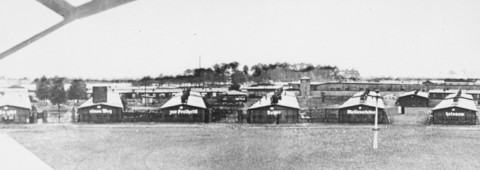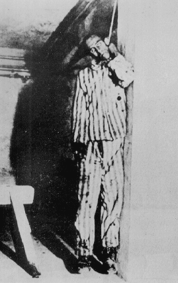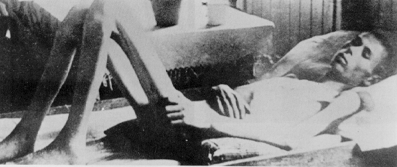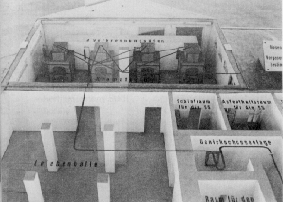Sachsenhausen - Oranienburg (Germany)
- Location: Germany, 35 km from Berlin
- Established on: 1938
- Liberation: April 22th, 1945, by a unit of the 47th Soviet Army.
- Estimated number of victims: 30 - 35,000
- Sub-camps: 44 sub-camps and external kommandos (click here for a list of those sub-camps)

General view of Saschsenhausen.
On July 12th, 1938, the first barrack of the camp was built by 50 inmates transferred from Esterwegen. In August and September 1938, 900 inmates were once again transferred from Esterwegen to Sachsenhausen in order to take part in the construction of the camp. Due to the lack of food and the incredible cruelties of the SS, most of them died during this period. End of September, the "Konzentrazions Lager Sachsenhausen" was ready and the first political prisoners arrived in the camp.
Beside the wooden barracks built for the inmates, there were several buildings built from bricks for the SS as well as several factories where the prisoners were used for slave labor. Before the beginning of the World War 2, most of the inmates were German communist or German Jews. Just after the "Crystal Night", 1,800 Jews were jailed in Sachsenhausen and killed in the following weeks.
In September 1939, thousands of communists, social-democrats and former trade union leaders were arrested in Germany. 5,000 of them were sent to Sachsenhausen, as well as 900 Jews. End of September 1939, there were 8,384 prisoners in the camp. In November 1939, this number increased dramatically to 11,311 prisoners. At this time, the first Typhus epidemic started. Because the SS refused to give any medical care and due to the incredible lack of food, hundreds of inmates died in the following weeks. Until April 1940, the dead were sent to the crematories installed in Berlin, located 35 km from Sachsenhausen. In April 1940, the first crematory was built in Sachsenhausen.

Sachsenhausen: Photo found on a SS.
Like all other Nazi concentration camps, the conditions of life in Sachsenhausen were incredibly barbaric. There were daily executions by shooting or hanging, i.e. 33 Polish inmates who were the survivors of a group of 320 inmates; or i.e. 88 Dutch civilian hostages killed by the SS in May 1942. A few weeks after the invasion of the Soviet Union by the Nazis, thousands of Soviet POWs were sent to Sachsenhausen. Most of them were killed by shooting or sent to the Punishment Company where they died by beatings, hangings, torture or starvation.

A survivor...
On January 31th, 1942, the SS forced a team of inmates to build the so-called "Station Z". This new installation was built for the extermination of the prisoners. On May 29th, 1942, the SS invited dozen of high ranked Nazi official for the inauguration of the new installation. In order to show them how the new installation was efficient, 96 Jews were killed by shooting. In March 1943, a gas chamber was added to the "Station Z". This gas chamber was used until the end of the war. The number of gassed victims is unknown because the transports for gassings were not registered in the entry registers of the camp.

Model of the "Station Z" in the museum of Sachsenhausen.
In 1944 and begin of 1945, due to the Allied advance, the number of prisoners increased dramatically. On April 20th and 21th, 1945, because of the Soviet Army advance, 33,000 prisoners were forced to leave the camp on a Death March. They were divided in groups of 400. The SS intended to embark them on ships then sink those ships. Thousands of inmates died during this Death March. They were killed by shooting because they were too weak to walk.
The camp was liberated by a unit of the 47th Soviet Army on April 22th, 1945. The Soviet soldiers found only 3,000 survivors in the camp. This number included 1,400 women. Most of them were starving, ill and too weak to welcome their liberators. Like in several other camps, and despite of the medical cares they received, many inmates died in the days following the liberation.
Sachsenhausen is a museum today. It can be easily accessed from Berlin.
Extract from the trial of Anton Kaindl,
former commandant of Sachsenhausen Death Camp
- Public Prosecutor: What kind of exterminations were committed in your camp?
- Kaindl: Until mid of 1943, prisoners were killed by shooting or hanging. For the mass exterminations, we used a special room in the infirmary. There was a height gauge and a table with an eye scope. There were also some SS wearing doctor uniforms. There was a hole at the back of the height gauge. While a SS was measuring the height of a prisoner, another one placed his gun in the hole and killed him by shooting in his neck. Behind the height gauge there was another room where we played music in order to cover the noise of the shooting.
- Public Prosecutor: Do you know if there was already an extermination procedure in Sachsenhausen when you became commandant of the camp?
- Kaindl: Yes, there were several procedures. With the special room in the infirmary, there was also an execution place where prisoners were killed by shooting, a mobile gallows and a mechanical gallows which was used for hanging three or four prisoners at the same time.
- Public Prosecutor: Did you change anything in these extermination procedures?
- Kaindl: In march 1943, I introduced gas chambers for the mass exterminations.
- Public Prosecutor: Was it your own decision?
- Kaindl: Partially yes. Because the existing installations were too small and not sufficient for the exterminations, I decided to have a meeting with some SS officers, including the SS Chief Doctor Baumkotter. During this meeting, he told me that poisoning of prisoners by prussic acid in special chambers would cause an immediate death. After this meeting, I decided to install gas chambers in the camp for mass extermination because it was a more efficient and more humane way to exterminate prisoners.
- Public Prosecutor: Who was responsible for the extermination?
- Kaindl: The commandant of the camp.
- Public Prosecutor: So, it was you?
- Kaindl: Yes.
- Public Prosecutor: How many prisoners were exterminated in Sachsenhausen while you were commandant of the camp?
- Kaindl: More than 42,000 prisoners were exterminated under my command, this number include 18.000 killed in the camp itself.
- Public Prosecutor: And how many prisoners died by starvation during this same period?
- Kaindl: I think 8,000 prisoners died by starvation during this period.
- Public Prosecutor: Accused Kaindl, did you receive the order to destroy any evidence of the murders committed in the camp?
- Kaindl: Yes. On February 1st, 1945, I had a conversation with the chief of the Gestapo, Muller. He ordered me to destroy the camp with artillery bombing, aerial bombing or by spraying gas. But due to technical problems, this order coming directly from Himmler was impossible to fulfill.
- Public Prosecutor: Suppose that there was no technical problem, would you have carried out this order?
- Kaindl: Of course. But it was impossible. An artillery or an aerial bombing was impossible to hide from the local population. And spraying gas was too dangerous for the local population and the SS.
- Public Prosecutor: What did you do then?
- Kaindl: I had a meeting with Hohn and some others SS and I ordered to exterminate all the ill prisoners, those who were unable to work and, the most important, all the political prisoners.
- Public Prosecutor: Was this order fulfilled?
- Kaindl: Yes, partially. During the night of February 2th, the first prisoners were killed. There were plus or minus 150 prisoners. Until end of March 1945, we succeed in killing more than 5,000 prisoners.
- Public Prosecutor: Who was in charge of this operation?
- Kaindl: Accused Hohn was in charge of this operation.
- Public Prosecutor: How many prisoners were in the camp at this time?
- Kaindl: Approximately 45,000. On April 18th I was ordered to embark all the prisoners on barges and to conduct the barge on the Baltic sea where I had to sink it. But we had not enough time to find enough barges for so many prisoners because the Red Army was advancing too fast.
- Public Prosecutor: What happened then?
- Kaindl: I ordered the evacuation of all the prisoners able to walk, first in direction of Wittstock, then to Lubeck where they had to embark on ships and sunk.
- Public Prosecutor: Did the prisoners received any care during this evacuation?
- Kaindl: No. 7,000 prisoners received nothing because we had nothing to give them.
- Public Prosecutor: Did these prisoners died by starvation during this Death March?
- Kaindl: Yes.



